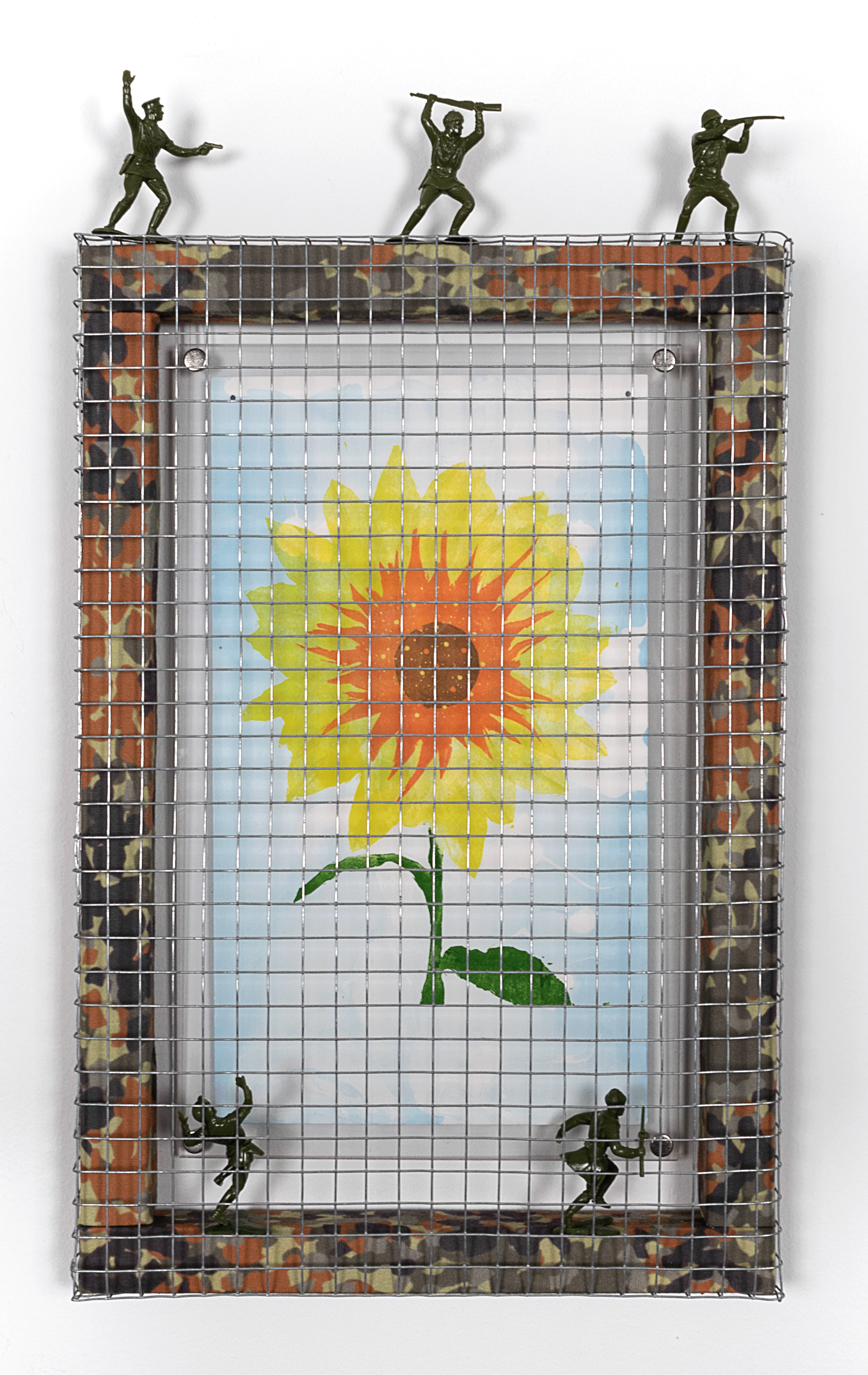Variation #5
By KS Lack
Print: Variated Edition 17/18
Frame: unmarked camouflage (Russian), Russian plastic army men, wire fencing
Ten years ago, on February 27, 2014, heavily armed men wearing green uniforms without identifying insignia seized control of the Crimean capital, Simferopol, and the independent city Sevastopol. Over the following days, Crimea was overrun by these “little green men” (zeleni cholovichky), as they came to be called. The name was ironic: Ukrainians knew exactly who these soldiers were, even without official identification, which is required by international law. The uniforms were Russian. The guns were Russian. Their vehicles had Russian plates. The soldiers spoke Russian with Russian, not Ukrainian, accents. They were Russian invaders.
At the time, however, the Russian government denied any responsibility. Russian Defense Minister Sergei Lavrov stated: “If you mean the self-defense units created by the inhabitants of Crimea, we give them no orders, they take no orders from us.” The Russian government continued this game of cat and mouse with the truth for years. While Putin admitted to sending forces into Crimea the 2015 Russian documentary Crimea, the Way Home, he was still denying his involvement to Western media outlets as late as 2018.(A)
Why invade Crimea? It was not to gain access to the Black Sea; the Russian Federation already had that.(B) And although Putin later claimed that the “Russians” of Crimea had needed and wanted the “protection” of Russian federation—a dubious assertion, given the peninsula’s actual history— these claims have been discredited. Putin used the turmoil following the ousting of President Viktor Yanukovych during the Revolution of Dignity as a pretense to to invade Ukraine.
The consequences have been grim.(C) Occupying Crimea allowed Russia to strangle Ukraine’s access to their trade routes through the Black Sea(D), while transforming the civilian-occupied peninsula into an military base, which has been used to devastating effect against Ukraine over past decade. It also revealed the international community’s unwillingness to do more than verbally condemn Russia for once again invading another country’s sovereign territory.(E). Moreover, Russia’s blatant lies in the face of clear evidence set the stage for their subsequent denial of involvement when fighting broke out in eastern Ukraine in April 2014.(F)
The Crimean invasion was never an isolated event. It was a trial run for Putin’s expansionist agenda of “reclaiming Russian lands” and the first stage of a broader Russian assault that culminated in the full scale invasion of Ukraine in February 2022.
A) For more on Russia’s use of disinformation as a weapon, see Variation #3.
B) Sevastopol was founded as a Russian naval port in 1783 and was a key naval base for the Russian Empire and Soviet Union. The 1997 Partition Treaty granted Russia the vast majority of the Fleet. It also allowed Russia to maintain up to 25,000 troops and an array of weaponry and armaments on the leased bases. The treaty had been renewed in 2010 to extend until 2042.
C) For more on the invasion and its impact on Crimea’s native population, the Crimean Tartars, see Variation #24.
D) For more on Russia’s embargo of Ukrainian trade routes, see Variation #11.
E) Russia’s invasion of Georgia in 2008 is one example.
F) For more on the start of the Russo-Ukrainian war, see Variation #27.
See below for further reading and background.
What Invasion? Russian Denials on Crimea Trigger War of Words, NBC News, 06 Mar 2014.
From 'Not Us' To 'Why Hide It?': How Russia Denied Its Crimea Invasion, Then Admitted It, RFE/RL, 26 Feb 19.
Were Crimeans really pro-Russian before annexation? LSE, 15 Nov 2022
Putin compares himself to Peter the Great in quest to take back Russian lands, The Guardian, 10 June 22.


